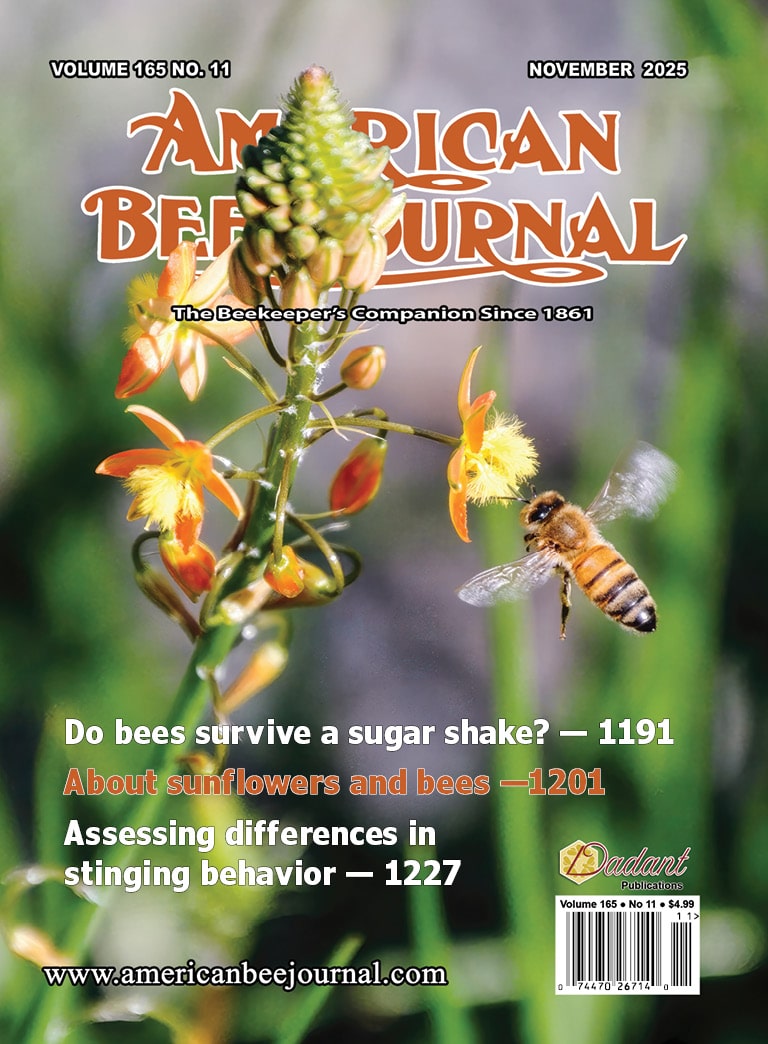High on the must-know list for a beginning beekeeper is how to read a proper comb pattern. Pull out a brood comb from the middle of a hive body and it will look something like this: a concentric series with brood in the middle, an arc of pollen above it, and the rest of the cells filled with honey (Fig. 1). Cells of brood are close to other cells of brood nearly the same stage. Any persistent deviation from this pattern is a warning that something’s not right.
Knowing that the natural nest cavity of Apis mellifera is a hollow cylindrical tree reminds us that this concentric pattern is a result of evolutionary time, and the pattern does not bend to accommodate our rectangular Langstroth hives. It may help to envision the natural A. mellifera nest as an upright ovoid egg with the yolk representing brood and the surrounding white representing stored pollen and honey (the analogy is better if you imagine the yolk having sunk to the bottom). Depending on where you longitudinally slice the egg, the yolk will appear bigger or smaller. Now imagine that egg constrained by the form of a rectangular box, and you get an idea of the nest situation with managed A. mellifera.
The center-to-edge pattern of brood-pollen-honey is so regular and fixed that it constitutes one of the descriptive constants of beekeeping books and biology texts. Moreover, the arrangement makes sense from an evolutionary perspective of selective adaptation. By positioning brood centrally, the colony optimizes incubation temperatures and minimizes temperature swings for the developing immatures. By positioning pollen immediately next to brood the colony facilitates its rapid access by protein-hungry nurse bees who synthesize and secrete worker-jelly for developing larvae. By positioning honey everywhere else – well, honey constitutes the most abundant of a colony’s stored natural resources and its specific location doesn’t matter so much.
Now because of these evolutionary rewards, it’s tempting to imagine that cell allocation and use patterns in combs is a fixed template imprinted on honey bee instinct: that bees “know” to put brood in the middle, pollen immediately above it, and honey immediately above that. The trouble with that approach is that it too quickly defaults to a vague and ultimately complex solution before it has exhausted simpler explanations based on inherent physical properties or actions of independent actors.
This gives us opportunity to pause a minute and consider one of the distinctives of science – and that is a bias in favor of explanations that are parsimonious, by which we mean explanations that are the most direct and invoke the fewest intermediary elements, actors, or steps necessary to reach the observed outcome. It helps to remember that we humans are by no means inclined to arrive at the simplest explanation for anything, even if we think the answer is the simplest and most direct. For example, the idea that honey bees “know” where to put things on the comb sounds simple enough, but in fact it implies a raft-load of assumptions about honey bee cognition, evolutionary fixation, and inheritance that are extremely difficult to untangle. The human mind, always hungry to detect order and quick to see human properties like volition, intentionality and forward planning everywhere in the natural world, is slow to accept answers based on explanations such as gravity, temperature, and the random actions of individuals. Part of the scientific process is recognizing this bias and its tendency to blind us to more direct explanations. Perhaps it was something like this that the 20th-C satirist H.L. Mencken was thinking about when he wrote, “For every complex problem there is an answer that is clear, simple, and wrong.”
For the last three months I’ve been …


